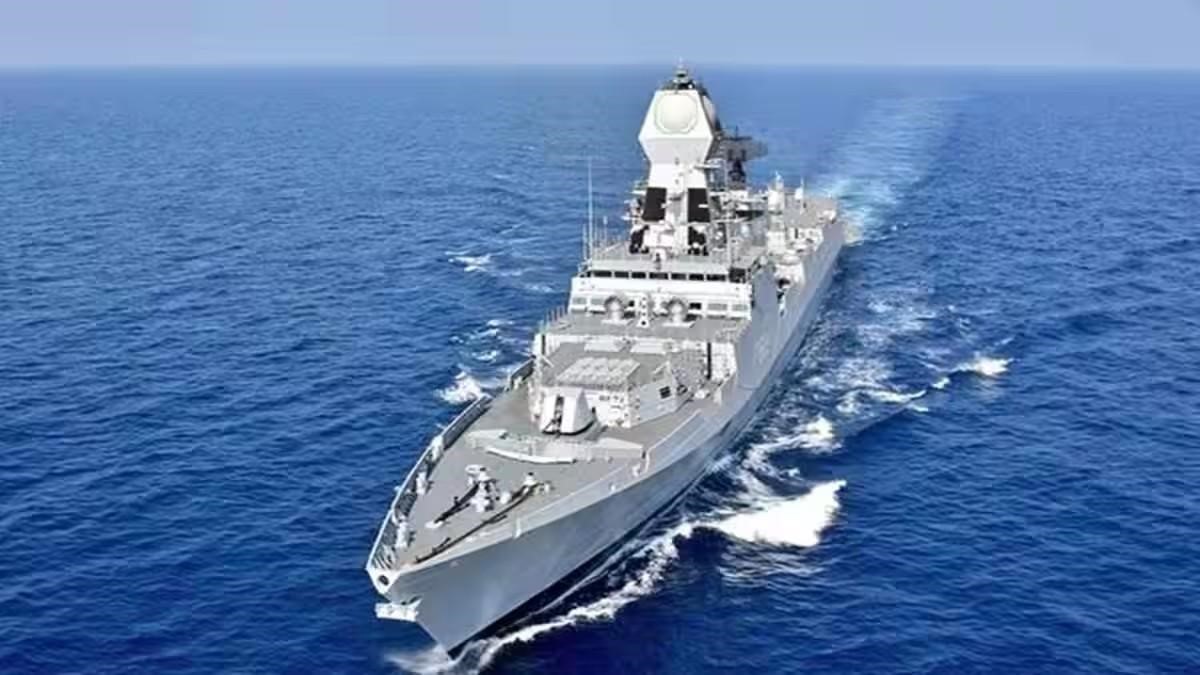India’s Naval Advancements: Path to Maritime Self-Reliance
Syllabus:
GS-2:
Government Policies & Interventions
GS-3:
Defence TechnologyIndigenization of Technology
Focus:
On January 15, 2024, Prime Minister Narendra Modi commissioned three major naval platforms — INS Surat, INS Nilgiri, and INS Vagsheer — built indigenously at Mazagon Dock. This milestone showcases India’s strides towards maritime self-reliance under the Atmanirbhar Bharat initiative.
A Milestone for Indian Naval Indigenization:
Unprecedented Triple Commissioning
- January 15, 2024: PM Modi commissioned three naval platforms:
- INS Surat: Destroyer under P15B Guided Missile Destroyer Project.
- INS Nilgiri: Indigenously built frigate.
- INS Vagsheer: Enhancing undersea combat capabilities.
- Built at Mazagon Dock, showcasing progress in Atmanirbharta.
Symbolic Importance
- Modi referenced India’s maritime heritage (Chola dynasty, Chhatrapati Shivaji Maharaj).
- INS Surat: 75% indigenous content, reflecting manufacturing advances.
Key Efforts Taken by the Navy for Indigenisation:
- Indian Navy Indigenisation Plan (INIP) 2015-2030
- INIP 2015-2030 launched in 2014 for indigenous development.
- Over 3400 items indigenised including:
- 2000+ machinery/electrical spares.
- 1000+ aviation spares.
- 250+ weapon spares.
- Naval Aviation Indigenisation Roadmap (NAIR) 2019-22
- Revision underway for NAIR 2022-27, focusing on high-cost repairs and mandatory spares.
- Emphasis on “fight” components (weapons and sensors).
- Indigenisation Committees
- Four in-house committees for naval aircraft spares.
- Naval Liaison Cells (NLCs) as indigenisation cells.
- Shipbuilding Efforts
- 41 ships/submarines under construction, with 39 built in India.
- 78% AoN (by value) and 68% contracts (by value) awarded to Indian vendors.
- Collaboration with DRDO
- Collaboration with DRDO to reduce development timelines.
- Focus on anti-submarine weapons, electronic warfare, communication systems, and combat management systems.
- Naval Innovation and Indigenisation Organisation (NIIO)
- Established NIIO in August 2020.
- Over 36 IPRs filed and transfer of technology to MSMEs.
- User Inputs Under Naval Project Management Teams
- User inputs provided through Naval Project Management Teams working with DRDO.
- Supporting futuristic technologies and 100+ DRDO projects.
- Make I & Make II
- Over 20 Make I & Make II cases being progressed.
- Make I: Government-funded, large platforms like light tanks.
- Make II: Industry-funded, prototype development for import substitution.
Indigenisation of Defence:
- Definition
- Indigenisation = developing and producing defense equipment domestically to achieve self-reliance and reduce import dependence.
- Key Objectives
- Aimed at self-reliance in defense manufacturing.
- Led by DRDO, DPSUs, and private organizations.
- India’s Defense Imports
- India as a major arms importer.
- USD 130 billion defense spending expected over next 5 years.
- Related Initiatives
- Increased FDI limit from 49% to 74%.
- Corporatization of Ordnance Factory Boards.
- Defense India Startup Challenge.
- SRIJAN Portal for vendor access to indigenization opportunities.
India’s Maritime Capability in the Global Context:
- Global Naval Power Rankings
- United States: Leads with 243 naval units, True Value Rating (TrV) of 323.9.
- China: Second with 422 platforms, TrV of 319.8.
- India: Ranks seventh, with 103 units and TrV of 100.5.
- Comparison with China
- China: Dominant in the Indo-Pacific region.
- India lags behind in shipbuilding efficiency:
- INS Surat: Built in 31 months, compared to 5 months for a similar Chinese frigate.
Challenges to Maritime Self-Reliance
- Shipbuilding Technology
- India’s manufacturing capabilities need substantial improvement.
- Investments in technology and efficiency are crucial.
- Indigenization Quality
- INS Surat: Despite 75% indigenization, critical ordnance packages are imported.
- Indigenous successes like BrahMos missile require scaling.
- Defence Spending
- India’s 2023 defense budget: $84 billion (17-18% for the navy).
- Comparatively, the S. ($916 billion) and China ($330 billion) allocate 25%+ to navies.
Maritime Strategic Vision
- SAGAR Initiative
- SAGAR (Security and Growth for All in the Region): Modi’s 2015 vision for the Indian Ocean Region (IOR).
- Emphasis on an open, secure, inclusive Indo-Pacific, countering China’s assertiveness.
- First Responder Role
- Indian Navy: Recognized as a first responder in the IOR for security and humanitarian challenges.
India’s Maritime Aspirations and Limitations
- Potential as a Maritime Power
- India’s maritime geography and historical legacy provide opportunities.
- Significant upgrades in naval strength are necessary.
- Indigenous R&D
- R&D in military technologies lags, limiting self-reliance.
- Enhanced design proficiency is needed for core capabilities.
The Way Forward:
- Strategic Investments
- Increase naval funding to global standards.
- Strengthen shipbuilding efficiency and invest in advanced technologies.
- Policy Reforms and Collaboration
- Streamline policies for private sector participation in defense.
- Foster international technology transfer and joint ventures.
- Sustained Focus on Atmanirbharta
- Focus on tangible progress over symbolic gestures.
- Defense Minister Rajnath Singh must ensure meaningful indigenization
Conclusion:
India’s naval strides, such as commissioning INS Surat, INS Nilgiri, and INS Vagsheer, mark progress toward Atmanirbharta. However, challenges in technology, funding, and indigenization must be addressed for India to emerge as a formidable maritime power.
Source: IE
Mains Practice Question:
Discuss the challenges and opportunities in India’s quest for maritime self-reliance under the Atmanirbhar Bharat initiative. Evaluate the significance of indigenously built naval platforms like INS Surat and their role in strengthening India’s maritime strategy. (250 words)




